Restoration of Sir John Johnson Family Vault
A joint project of
Sir John Johnson Centennial Branch UELAC
and
La Société de restauration du patrimoine Johnson
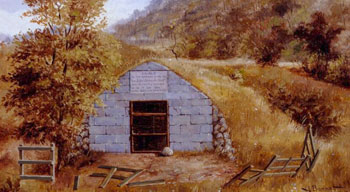
Mount Johnson, Vault of Sir John Johnson
Painting by Henry Richard S. Bunnett, 1885
©McCord Museum
Click here for a larger version
2011: UELAC 2014 Centennial Project
5 March, 2011

The complete vault restoration project is available as a PDF. The PDF contains financial information about the product that is not available as HTML on this page.
Click here to download the PDF
In 1967, the United Empire Loyalists' Association of Canada formed its first branch in the Province of Quebec. And this new Branch chose to honour both Canada's Centennial and a great Loyalist, Sir John Johnson, by naming the branch, the "Sir John Johnson Centennial Branch". Since the Province of Quebec was the home of Sir John Johnson for so many years and many members of his Regiment came to live in this part of the country, it seems most fitting that this new Branch be named in his honour.
Sir John Johnson
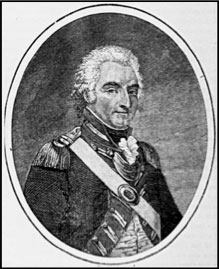
Sir John Johnson (photo), the only son of Sir William Johnson and Mary de Wissenberg, was born in 1742 at Johnstown, in the Mohawk Valley, Province of New York. His father, who emigrated from Ireland as a young man, became the richest landowner in the then Province of New York. William Johnson held the position of Superintendent General of Indian Affairs for the British Government.
During the Seven Years War, when the French and English were fighting for control of North America, at age 13, John accompanied his father and took part as a volunteer in the Battle of Lake George, where his detachment defeated the French troops. For their effort in taking an active part in the French and Indian War, from 1755 to 1763, William Johnson received a baronetcy and John was promised a knighthood when he became 21. In 1765 at the age of 23, John was knighted for his services.
Sir John married Mary Watts, fondly known as Polly Watts and daughter of John Watts, President of Council of Colonial Affairs in New York City. Over the years they had 11 children. Sir John succeeded to the Baronetcy on the death of his father in 1774, becoming the Second Baronet of New York and inherited vast properties, including Johnson Hall, all of which he had to leave when forced to flee to Canada in 1776.
When the hostilities erupted in the British colonies, Sir John remained loyal to the King. He was forced to escape to avoid capture by the rebel troops. When he arrived in Montreal, Sir John formed the King's Royal Regiment of New York, also called the Royal Greens. His troops made frequent raids on the Mohawk Valley to rescue other Loyalist members and to destroy the rebel provisions and they defeated the Americans in the bloody battle of Oriskany. In 1782, Sir John Johnson was made Brigadier of Provincial Troops.
When the American Revolution ended, those who had fled realized that they would never again be allowed to return to their land. All of Sir John's personal estates along with that of thousands of other Loyalists were confiscated. It was Sir John who was assigned the task of settling the Loyalists into their new homes. He organized and supervised the settlement in 1784 of the Loyalists on the upper St. Lawrence and the Bay of Quinte and by so doing became the founder of the Province of Ontario. Then he was named Superintendent-General and Inspector-General of Indian Affairs in the Canadas. Later he became a member of the Legislative Council. He is considered to be the foremost of the United Empire Loyalists in Canada. He continued to be for many years Superintendent of Indian Affairs, and a figure of great influence in Lower Canada.
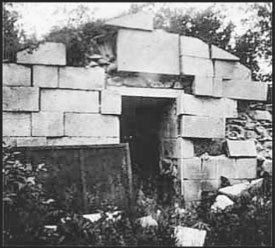
This photo of Sir John Johnson’s tomb was taken in 1940 by Sir Gordon Johnson, Fifth Baronet of New York, and sent to The Loyalist Gazette by the Sixth Baronet, Sir John Paley Johnson.
He died in January 1830 at the age of eighty-eight. His funeral, performed by the Reverend Mr. Stevens, Chaplain of the Forces, was largely attended by relatives, Indians and Freemasons. His funeral service was held at the original Christ Church Cathedral on Notre Dame Street. Montreal had never seen such a grand and picturesque funeral procession. It included the 24th Regiment and Band, members of the Masonic Lodges in their regalia (Sir John Johnson had been Provincial Grand Master of the Freemasons) and several hundred Indians. They paraded to a landing stage at the Montreal Harbour where a boat was waiting to convey the body across the St. Lawrence River to the south shore for interment in the family vault on Mount Johnson (now known as Mont Saint-Grégoire), near the village of Saint-Grégoire, not far from Saint-Jean-sur-Richelieu).
Sir John was buried beside the remains of his wife, Lady Polly, and four of their children in the family vault on the south side of this mountain, the side facing toward Sir John's birthplace in the Mohawk Valley of New York. It is this crypt that was accidentally bulldozed 50 years ago and that we are now working to restore.
Sir John Johnson's family vault
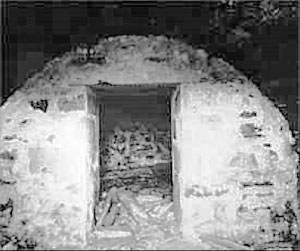
Sometime during World War II, the Johnson family vault was vandalized, the door pried open allowing animals and humans to enter (photo). The lead of the roof was taken and the structure fell into a state of disrepair. By 1957 the facing stones had almost all fallen away. In the fall of 1957 or 1958, at the request of the owner of the land, a large hole was dug and the vault was pushed into it by a bulldozer. No one realized at the time the importance of this tomb and even the fact that human remains were there, as it did resemble a root cellar.
Jean-Paul Lasnier, the owner of the landscaping company, commented forty years later that he had been hired by a local apple-grower to clean up a pile of rocks that sat smack in the middle of a 40-acre orchard. At the time he was a contractor and he had a job to do. He added, "In those days, you didn't pay much attention to history. I had never heard of Sir John and I didn't know it was a burial site until I spotted a few bones about an hour into the landscaping job." Just the same, the job was completed in less than two hours and he was unaware he would live to regret his deed, which he would later say was "the biggest mistake of my life."
Gravestone of Sir John Johnson
Fortunately, Sir John's stone survived, although the wording was badly eroded. In the mid-1960's, the owner of the property, Romuald Meunier, found the stone lying in the grass behind his barn and recognized it as something worthy of preservation. In 1967, the Sir John Johnson Centennial Branch was formed, and members of the Branch learning of the existence of the tombstone visited the site at Mount Johnson in November 1968. They saw the monument erected for Sir John Johnson. The question arose as to what should be done about it. It was decided to write to the Sir John Paley Johnson, 6th Baronet of New York, descendant of Sir John Johnson, and ask what should be done with the monument. Sir John made the wish that the monument be preserved. Always interested in the activities of Sir John Johnson Centennial Branch, Sir John Paley Johnson became the Honourary President of our Branch in 1975. He was succeeded the following year by Sir Peter Colpoys Johnson, 7th Baronet. And since 2003, our Honourary President is Sir Colpoys Guy Johnson, 8th Baronet of New York.
And at a meeting of the Branch held during the autumn of 1969 at the Protestant School in Clarenceville, Murray Mason reported getting the gravestone of Sir John Johnson from Mount Johnson and transporting it to Stanbridge where it was placed at the museum. The Missisquoi County Historical Society granted permission to have the gravestone placed in a niche in the wall which was done the following year when the new part of the museum was bricked. So the stone, which bears the barely-legible inscription, Sacred to the memory of the Honourable Sir John Johnson Bart who departed this life of the 4th Jan. 1830, aged 88 years, was repaired and installed in the outside wall of the Missisquoi Museum at Stanbridge East, where it remains today. But the old stone was in such bad condition and much of the lettering was hardly discernable so that re-lettering of the stone was practically impossible to do. It was therefore decided that a plaque would be placed beside it.
This bronze plaque reads as follows: 1742–1830 – Sir John Johnson – Indian Commissioner and a foremost Loyalist from New York State, who led the Loyalist Regiments during the Revolutionary War. Buried at Mount Johnson, Que. – Erected by the Sir John Johnson Centennial Branch of The United Empire Loyalists.
A simple marker in memory of Sir John Johnson
In 1977, 147 years after the death of Sir John Johnson, only three people could remember the exact site of Sir John's grave which had been vandalized and bulldozed over during the intervening years. Before even this could be lost to posterity, a small group of local historians gathered on Mont Saint-Grégoire, to plant a simple marker in his memory.
There are several worthy memorials to Sir John in Ontario, particularly at Crysler Memorial Park near Upper Canada Village and Sir John Johnson House National Historic Site of Canada, in Williamstown. The importance of Sir John Johnson's role as one of the founders of British Canada is commemorated by a memorial plaque to his honour at the Crysler Battlefield Memorial Park which was formally presented on June 24, 1961 by Sir John Johnson, 6th Bt, in the presence of the Prime Minister of Canada. And at Williamstown, where a group of local citizens formed the Sir John Johnson Manor House Committee and are actively working with Parks Canada, to ensure the long term protection of the manor house.
In the Mohawk Valley of New York State, there are two memorials to the Johnson family, Johnson Hall and Old Fort Johnson. Johnson Hall, in Johnstown, has become a national monument, the Johnson Hall State Historic Site. Sir William Johnson's home from 1763 to 1774, the year of his death, and the home of Sir John, from 1774 to 1776, was purchased by the State of New York in 1907 and transformed into an historic site.
And old Fort Johnson, built by Sir William in 1749 and his home until 1763 when he removed to Johnson Hall, and where Sir John lived until 1774, is now the home of the Montgomery County Historical Society.
But here in the Province of Quebec, Sir John Johnson had been less well remembered. On the Mont St. Gregoire site there was still no national memorial, no fine monument, no plaque of any kind to indicate the actual resting place of Canada's Foremost Loyalist. At least not yet.
Restoration of the family vault
No one was more enthusiastic in restoring the Johnson family vault crypt than Jean-Paul Lasnier, the man who had been hired some years back by the owner of the propriety, Mr. Meunier, to clear the land.
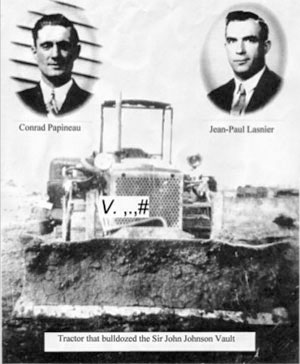
Mr. Lasnier, who was the Mayor of Sainte-Brigide-d'Iberville, was feeling very remorseful at having buried the vault all those years ago. He claimed that, while bulldozing the site, to have seen what he believed were human bones as he pushed the vault off its base into a pit. His story came to the attention of the Société d'histoire du Haut-Richelieu, within whose jurisdiction the burial site was located, and also to the attention of the Sir John Johnson Centennial Branch. A group of members researching the facts surrounding the vault became convinced of the veracity of Lasnier's report
With the growing concern that a legitimate historical site had been despoiled resulted in the creation, on May 13, 1998, of the Société de restauration du patrimoine Johnson, an association founded by Jean-Paul Lasnier and the Société d'histoire du Haut-Richelieu. The board was formed of Jean-Paul Lasnier, president, Marie Deschênes, owner of the land and Claude Neveu. Also on the board, representing the Sir John Johnson Centennial Branch were Richard Eldridge, Brian Allen and Charles Harbec; finally, Nicole Poulin, representing the Société d'histoire du Haut-Richelieu, acting as secretary. The purpose of the Société de restauration du patrimoine Johnson, a non-profit heritage association determined to restore Sir John's crypt, is: first, to locate exactly where the vault had been situated; second, to prove that indeed Sir John Johnson was buried there; and third, to endeavour to restore the site therefore restoring to Sir John Johnson the dignity that he deserves and to elevate his prominence in history.
At the annual meeting held on June 6, 1998, at the Legion Building in Philipsburg, it was reported that Richard Eldridge and Brian Allen, representing the Sir John Johnson Centennial Branch, were joining a group from the Richelieu Valley Historical Society who were in the process of arranging to place some suitable type of memorial stone at the site of the burial crypt of Sir John Johnson. At the time, the owners of the property, working with the committee, approved of this placing a memorial on their property. It was hoped that this could be done in a very near future.
That summer of 1998 following the Branch annual picnic held at the museum in Stanbridge East, several members went to Mont Saint-Grégoire at the old Johnson property where they were welcomed by the owners. Then they were escorted by Richard Eldridge to the spot where the vault had once stood. There they all noticed that the steel rod placed by the Sir John Johnson Centennial Branch in 1977 was nowhere to be found.
At the semi-annual meeting of the Branch held on October 18, 1998, Mme Nicole Poulin, Secretary of the Société de restauration du patrimoine Johnson and President of the Société d'histoire du Haut-Richelieu, was the guest speaker. She said that the members of the restoration society were hoping to raise enough money to cover the expense of unearthing the vault and building a new one. But she added that the government would be sending an archaeologist the following spring before permission to continue could be granted. That same year, greatly supporting the project of the restoration of the family vault, Sir Peter Johnson, 6th Bt, gave permission to excavate the vault.
At the Branch annual meeting of June 5, 1999, Dick Eldridge reported that plans for restoration of the burial site were progressing slowly and they were still awaiting the visit of the government archaeologist to ascertain if people were buried in this site. As far as they could tell the remains of six or seven people were in the vault. At the time, it was estimated that it would take $30,000 to bring the vault out of the ground and rebuild it. Still some work was being done. The vault's foundations had been uncovered and a certificate of localization had been obtained for the area which is approximately two hundred square meters. But because of Provincial regulations, no further excavations could not be done until a visit by an archaeologist expected in the following weeks.
On November 11, 1999, a forensic pathologist from Montreal said that he had found human bones at the Johnson burial crypt and that these bones were being taken to the lab for testing. The cost of this work was $5,160. During this first archaeological excavation, 129 bones (including fragments) were retrieved.
At the Branch annual meeting of June 2, 2001, it was reported that the restoration of the Sir John Johnson burial site continued to be a top priority of our Branch but, as in many projects of this type, the wheels of law were turning very slowly and, as in most cases, legal documentation takes time.
From 1998 to 2001, more than $14,000 was raised through government, UEL, historical societies and private donations.
President Richard Eldridge announced at the Branch annual meeting held at the Philipsburg Legion on June 1, 2002, that Nicole Poulin, President of the restoration committee had reported that the Société d'histoire du Haut Richelieu had given $2000 to be used toward the completion of the archaeological excavation at the tomb site and the Government of Quebec would give another $3000 so the work could continue the following fall.
On October 14, 2002, the final necessary archaeological research started with hopes of completing this stage of the work before the winter season. After this work completed, the plan was that the remains that had been retrieved were to be re-interred with appropriate consecration. And the next step toward completion of this project was to rebuild the vault over the spot where the remains were buried.
During this second archaeological research, more bones were found, a total of 851 bones and bone fragments (total including those found in the first excavation). All the bones were analyzed. And they were carefully preserved at the University of Montreal in the office of osteo-archaeologist Gérard Gagné, before they were taken to Quebec City to repose there until we are ready to receive them for proper burial. This completed Phase I of the project at a cost of $14,140. 26. The funds raised totalled $14,227.50.
At the Branch semi-annual meeting held on November 2, 2002, in Brome Village, Nicole Poulin reported that the site of the Sir John Johnson burial vault had now been designated by the Quebec Ministry of Culture and Communication as an Archaeological Site as well as being considered an Historic Site, the first historic archaeological site in the Province of Quebec that is not an Indian site.
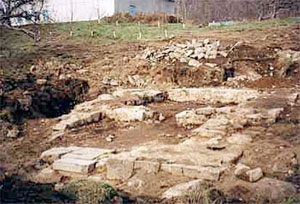
At the following annual meeting held on June 14, 2003, Richard Eldridge presented to the Branch members the findings of the completed 100 page provincial report of Phase I. The report summary confirmed the presence of the remains of at least seven adults and three to five children. The report also suggested that the skeletal remains of one elderly man with extensive arthritis and ossification may be the remains of Sir John himself, and added that a second male adult with an estimated age of between 30 and 40 years could be his son William. The report also confirmed the remains of a third adult estimated not to be older than 45 years of age, and the bones of a lone female who might be those of Polly Johnson, Sir John's wife.
We also learned that the Société de restauration du patrimoine Johnson was once again in a waiting mode, now that the archaeological survey had been completed. But the committee was still striving to raise money to go ahead with Phase II, the actual restoration of the crypt. The objectives of Phase II are to obtain the legal right of way to the site, to obtain a legal deed for the site, to restore the vault, to return the bones for proper reburial, to hold a rededication ceremony, and after, to maintain the site.
At an executive meeting of the Sir John Johnson Centennial Branch held on April 22, 2005, Dick Eldridge reported some very good news, although Phase II had still not begun. He had just received a letter from Branch member, Raymond Ostiguy who after considerable research had found a deed dated October 17, 1833 of a sale of the involved property that appeared to show "a right of way" from the road to the vault. It was hoped that this find would lead to obtaining a legal access to the site. Later that year, the Branch members learned that the farm where the Johnson vault is located was sold, and that the new owners, a society named CIME, were quite receptive to the continuation of the efforts to restore the burial vault.
On January 27, 2006, the Société de restauration du patrimoine Johnson met at the home of Claude Neveu in Sainte-Brigide. In spite of his frail health, Jean-Paul Lasnier, President of the restoration society, was present. This meeting reported that the Verger Monnoir where the Johnson Vault is located was now the property of CIME Haut-Richelieu (Centre d'interprétation du milieu écologique du Haut-Richelieu), an organization founded in 1981 with the mission of protecting and valorizing Mont Saint-Grégoire. It seemed that these new owners are interested in cooperating with the restoration committee.
On Christmas Eve 2006, Richard Eldridge, Immediate Past President of Sir John Johnson Branch and treasurer of the Johnson vault restoration committee died after a long and courageous battle with cancer. It is sad that he did not live to see the completion of the project of the vault restoration, project for which he worked so hard.
At the annual meeting held at the Philipsburg Legion Hall on June 9, 2007, Raymond Ostiguy gave to the members an update on the Sir John Johnson Family Vault: "Following the acquisition by the CIME from Marie Deschenes of the property upon which is located the Johnson Family Vault, a meeting was arranged with the new proprietors at the site on November 13, 2006. The main parking lot had recently been extended following the demolition of what remained of a former warehouse on the property destroyed by fire. CIME now has its offices in the former Deschenes residence. The meeting was held there. CIME, owner of the top portion of Mont Saint-Grégoire since 1994, is receptive to plans to protect, preserve and restore the Vault. The Société de restauration du patrimoine Johnson was asked to prepare a brochure on the importance of the Johnson Family and the occupancy of the seigniorial manor house, windmill and vault on the site. It is clearly recognized that common values are shared by the two organisations. CIME has maintained, and exploits for visitors, a network of interpretive trails that closely mirrors the pattern used by the Johnson family."
The site was surveyed by Eric Denicourt, surveyor, in November 2010. At a meeting of the Société de restauration du patrimoine Johnson held on December 6, the total cost of Phase VI of the restoration of the vault was estimated at $80,000. And on December 15, Claude Neveu, President of the Société de restauration du patrimoine Johnson met with Marie Bourelle, member for Iberville in the Quebec National Assembly, and asked for financial assistance from the Minister of Culture, Communications and the Status of Women.
The plan below is a portion of a survey conducted by Alexander Stevenson for Sir John Johnson in 1824. The following year Sir John conveyed to his three daughters a part of three of his lots at Mount Johnson upon which was located the "Family Vault" (as shown on the plan). Sir John retained his interest in his "Country seat" upon which his manor house and other buildings were located. The dotted lines trace the road network.
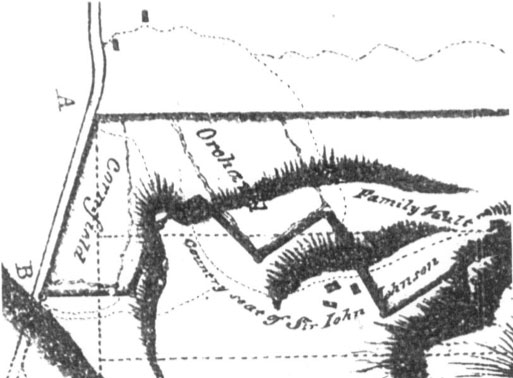
When what remained of the original parcel was sold by Archibald Kennedy Johnson to Judge Jean Roch Rolland in 1833, the land upon which the Family Vault was located, "with an acre of ground round the same", was reserved out of the sale to be retained by the Johnson family interests. The drawing below is a part of a plan of survey prepared some years ago by Surveyor Denicourt of the location of the vault. Both the circle and the square traced around it represent an area of approximately one acre. The bâtisse shown on the plan was a storage building that subsequently burned down. The parking lot is located there now. The access to the parking lot is by the road shown on the plan.
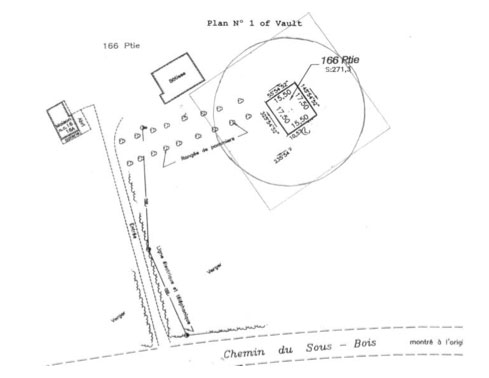
As a result of negotions with CIME, the current property owner, an agreement was reached as to an extent of land to be utilized for the purpose of the restoration Project. Last fall, Mr. Denicourt surveyed and staked the parcel and prepared the plan, a portion of which appears below. While the area in question is less than an acre, there are large areas in front and to one side of the vault (as shown on the plan) that will be available for receiving visitors, interpretation panels, and to serve as landscaped open spaces. The house on the left is the building currently used by CIME for its offices.
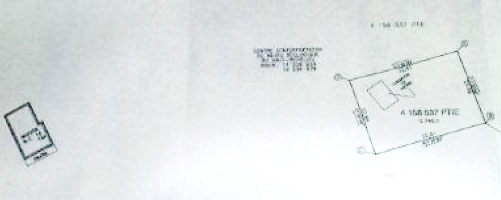
The plan below is a blow-up of the parcel to be retained after completion of the Project. The foundations of the Vault are outlined in the upper left-hand corner.
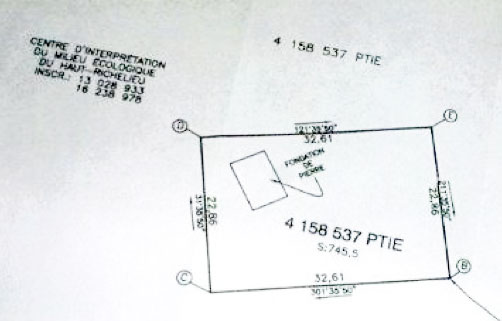
The Estimate appearing at pages 12 and 13 describes the work and the various steps contemplated by the Project. It is hoped that an agreement can be concluded with CIME by the end of April 2011 so that the preliminary site work (locating and cleaning stones, preparing site) can commence as soon as conditions permit. The masonry work would be undertaken between May and August, 2011, followed by the roof, installation of hardware and electrical fixtures and finally by the landscaping to complete the Project before the end of September, 2011.
Summary and Conclusions
In conclusion, the Sir John Johnson Centennial Branch proposes a Centennial Project worthy of consideration by all of the members of UELAC: the Restoration of the Sir John Johnson Family Burial Vault at Mount Johnson (Mont Saint-Grégoire), Quebec. It is a project of considerable magnitude and importance to Loyalists and their descendants, particularly as it is intended to pay tribute to the contributions of the Johnson Family and specifically to Sir John Johnson, perhaps one of the most underrated and overlooked leaders of that migration movement. Our Branch has already been actively involved in it for a number of years.
The Vault, or what remains of it, is located on the southwest slope of Mont Saint- Grégoire (about 40 kilometres south and east of Montreal) on land recently acquired by a nonprofit organization, CIME (Centre d'interprétation du milieu écologique du Haut Richelieu), dedicated to developing the mountain as an ecological park open to the public. Our Vault Committee has been working in close cooperation with this group.
Likely constructed at the beginning of the 19th century, the Vault served for Johnson Family burials from 1812 until at least 1843. According to Sir John Johnson's burial certificate dated January 8, 1830, after "the burial service was read over the body in Christ Church … the body was afterwards taken for interment to his Family Vault at Mount Johnson". A painting rendered of it by H.R.S. Bunnett in 1889 (see page 2), discloses the Vault's earlier appearance. Unfortunately, it suffered considerably from looting and vandalism during the 20th century.
During the late 1950s a former owner had it bulldozed into a trench, where it remained undetected until the initiation of the first phase of the Branch Project. Once the remnants were located, the site was subjected to two archaeological explorations in 1999 and 2002. These established its dimensions and the nature of its construction. Human remains (bones) were found, analyzed and have been removed to Quebec City. Both the Province of Quebec and the Regional Municipality have formally recognized the archaeological significance of the site.
Phase VI of the Project involves the reconstruction of the Vault, the preparation of an appropriate commemorative plaque, the return of the human remains and a formal rededication, all of which we expect can be completed before 2014. As to the other elements of the "Country seat of Sir John Johnson" identified in 1825, (Manor House and other buildings, including a six-story stone windmill) it is hoped that the commemoration of these, with CIME's collaboration, can also be added to the Project. Already the walking trail system promoted by CIME follows the old Johnson road network.
We believe our Centennial Project proposal is worthy of consideration on behalf of all of the members of UELAC. In view of the close history of Sir John Johnson with the Freemasons and the Mohawks we also anticipate their interest in this project. We hope you will agree and favour us with an acceptance.
Our aim is to restore the Sir John Johnson Family Vault, making it a pleasant place for Loyalists and all other interested persons to visit and to recall the merits of Sir John Johnson's contribution to the birth and growth of the Canadian Nation.
Roderick Riordon UE, President,
Sir John Johnson Centennial Branch
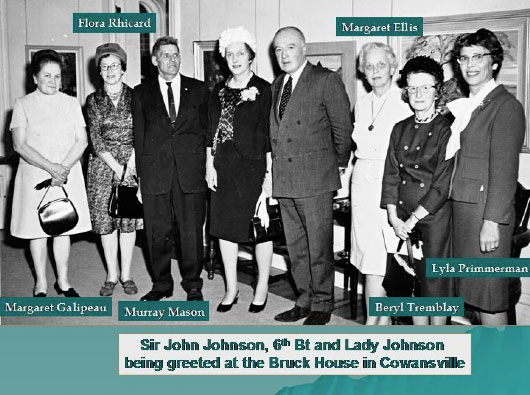
On the 16th of December, 1967, Sir John Johnson Centennial Branch received its charter from the UELAC. The first important event of the new Branch took place on April 24, 1968 with a special visit by Sir John Paley Johnson, 6th Baronet of New York and his wife Lady Johnson. They were greeted by Murray Mason UE, first President of the Branch, the executive and several members of the Sir John Johnson Centennial Branch of the UELAC.
